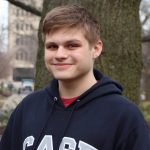 Joseph (Josh) Laurienzo
Joseph (Josh) Laurienzo
Home Institution: Case Western Reserve University
Status: Freshman, Expected Graduation Date: May 2021
Field of Study: Math and Physics with a Minor in Japanese and Spanish
Host Lab in Japan: The University of Tokyo – Dept. of Applied Physics and Quantum-Phase Electronics Center, Iwasa Laboratory
Host Professor: Prof. Yoshihiro Iwasa
Research Abstract and Poster: A Study of Novel Van der Waals Heterostructures (PDF)
Why Nakatani RIES?
The Nakatani RIES Fellowship provides me with the opportunity to simultaneously pursue two of my greatest passions in life: physics and Japanese culture. I have always had a deep love of science, and especially physics for to its ability to predict and describe so much of nature with so little given information. Through the program, I will be able to pursue physics at one of the world’s most renowned universities, and gain experience working with cutting-edge science. Furthermore, my appreciation for the Japanese language has lead me to develop an appreciation for the nation as a whole, including its rich history and literature. The program will allow me to truly immerse myself in the culture of Japan and experience the country in the flesh.
Goals for the Summer
- Improve my laboratory skills and contribute to science
- Become more familiar with the Japanese language and way of life
- Represent my home in the best possible light and have fun
Meaning of Nakatani RIES Fellowship (Post-Program)
The greatest meaning of the Nakatani RIES Fellowship to me was the opportunity to see how research is pursued abroad and to develop a deeper appreciation for Japanese culture. In so doing, I was able to put my own culture in perspective. It is hard to realize what is unique about yourself without seeing the differences of others.
Research Lab Overview
My research project was the creation and characterization of optically active van der Waals heterostructures. This project was very relevant to my current interests in physics, which lay in electricity, optics and solid state. Working in an international research setting was a welcome challenge that taught me how to communicate difficult ideas in simpler, more understandable ways. It also taught me to appreciate the cultural differences in approached to work. For example, most people in Japan do not leave the office until all of their work is finished while, in comparison, Americans often take their work home. My research was sometimes frustrating, as my project was changed after I spent several weeks working on my first topic, and I did not spend as much time in the lab as I wanted. I am grateful for being introduced to van der Waals heterostructures and hope to return to research with them, perhaps in graduate school.
The Iwasa group members have a great deal of freedom in their pursuits in the lab, and biweekly Saturday meetings are held where they present their progress in English. The group also seems to highly value international collaboration. Although we would eat lunch together every day, it did not seem like members did very much together outside of the lab. Although my mentors spoke English, it felt like there was still a large barrier between us. It is also interesting to note that Prof. Iwasa appears to value direct interaction with group members, and we would see him very often.
Daily Life in Japan
An average day in Japan during my research internship was waking up at 9:30, getting dressed, taking the subway, arriving at the office around 10:30. I would then either read physics papers or studying Japanese until there was something for me to do. We would go out for lunch at around 11:30 together every day and get back at around 12:15. After that, I would go back to reading until something came up for me to do. I would usually leave the lab around 6:30, go home, eat and sleep. My home was a share house of about 7 international renters, but most did not speak English. My favorite food was at a tempura restaurant between the station and the share house. Some days I would leave the lab earlier if I had nothing to do and go visit somewhere new in Tokyo.
On the weekends, I would either have meetings on Saturday that took the entire day or travel out a bit further in the city or to Chiba. One of the most rewarding things about my trip was slowly becoming more and more competent surviving on my own. The logistics of living in Tokyo are not simple, and learning how to navigate was challenging. It was especially fulfilling, however, to be able to read signs with increasing clarity as my Japanese improved and I could interact better with others, opening up many doors.
Cultural Experiences in Japan
The most meaningful experiences I had with Japanese culture were in noticing the little things. There are so many tiny rituals in daily life, such as the way cashiers hand back money and the way stores put out umbrella holders, that cannot be learned through reading that made me realize how idiosyncratic, the way people in America behave is. Also, the quality and aesthetic of almost all products in Japan have made me realize just how much attention Japanese society puts on form. Also, perhaps the most interesting thing I found is the simultaneous homogeneity and inhomogeneity of Japanese culture. Although Japan is a much more conformist society than the United States, it was incredible to see the diversity that exists throughout Tokyo. It has made me realize that the heart of a culture cannot be described, it must be felt.
My favorite experience in Japan was … probably our group trip to the Kamigamo Shrine and Kennin-ji Temple in Kyoto. Through the special opportunity we had to visit the inner areas of the shrine we were blessed with the ability to delve deep into the Kamigamo Shrine, whose atmosphere held an otherworldly serenity. It was also profound to see how the traditions of the past are so faithfully observed even today. The Kennin-ji Temple was also a once-in-a-lifetime opportunity, as we were permitted to visit on a day with no other visitors. Being able to see the real conditions Buddhist monks live in has put my “book knowledge” of Japanese theology into perspective. Furthermore, although not part of the shrine or temple, visiting the imperial study room during the same trip was also one of the many opportunities I did not expect, but for which I will forever be grateful.
Before I left for Japan I definitely wish I had … studied the spoken language more. Although many people in my lab spoke English to some degree, the quality of communication was often restricted to very literal conversations about basic things. Also, without speaking Japanese, it is much harder to go about daily tasks or make friends (although not impossible). It is also very important if one is studying in labs outside of Tokyo, where students’ English is perhaps not as developed. However, all of this said, there is no better way for one to improve their Japanese than to study it in Japan. Although I had already had some background (Genki I and II), seeing and having to use Japanese every day gave me constant practice and gave me better direction as to how to study further.
While I was in Japan, I wish I would have … spent more time trying to make friends. Although I enjoyed exploring Tokyo by myself, my time in Japan was often characterized by isolation.
Excerpts from Josh’s Weekly Reports
- Week 01: Arrival in Japan
- Week 02: Language Learning & Trip to Mt. Fuji Lakes
- Week 03: Noticing Similarities, Noticing Differences
- Week 04: First Week at Research Lab
- Week 05: Cultural Analysis – Life in Japan
- Week 06: Cultural Analysis – In the Lab & Preparation for Mid-Program Meeting
- Week 07 and 08: Overview of Mid-Program Meeting & Research Host Lab Visit
- Week 09: Research in Japan vs. Research in the U.S.
- Week 10: Reflections on Japanese Language Learning
- Week 11: Interview with a Japanese Researcher
- Week 12 & 13: Final Week In the Lab & Re-Entry Program
- Final Research Project Overview & Poster
- Follow-on Project
- Tips for Future Participants
Week 01: Arrival in Japan
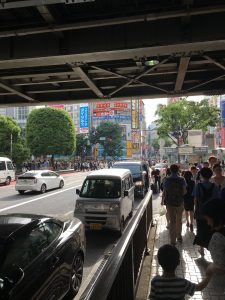
Upon landing in Japan, I was immediately surprised by how different the city layouts and building constructions were from the outside. On the bus ride from the airport, I was very impressed by the industrial buildings and roads that lay directly beneath the road we were on, and also by the massive buildings jutting out into the water near the entrance of Tokyo. I was very excited to investigate the convenient stores, and was blown away by the amount of products and brands unique from those in the US. The vending machines’ variety and relatively low prices were also a pleasant surprise. My room at the Sanuki Club is actually more spacious than I expected, and my living conditions are quite comfortable. I particularly appreciate the atmosphere in the hotel; it has a certain fragile situational beauty that cannot be fully captured with words.
In the full interest of honesty, though, my Japanese classes have been frustrating. The experiential-learning oriented approach does not suit my preferences well: I think I succeed more in analytic approaches to language learning. However, this said, I have definitely come a long way in terms of my speech and listening since landing, and am constantly becoming more enthusiastic about gaining a deeper understanding of the language. Studying Japanese by myself in the United States, it was sometimes difficult for me to motivate myself, but living in Japan reveals the immediate fruits of study. It always instills in me a deep sense of fulfillment to read a sign in Japanese and understand what it says, or ask someone a question or offer an explanation, especially regarding words or grammatical structures I have only recently learned. I have also improved my body language, learning how to gesture out words or phrases that I may not be familiar with (like wrapping paper).
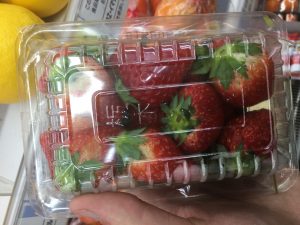
My activities in Japan have definitely been exhausting, and I don’t think I’ve ever spent so much time walking in my life. The exercise is probably good though in that it offsets the ridiculous amount of calories I have been consuming in my quest to try all of the food Japan has to offer (including the eye of a sea bream). The University of Tokyo’s campus was breathtakingly beautiful, displaying in full force the concept of kata with its wild pond in the heart of Tokyo. The Taiko drumming was a unique experience, and while I struggled, it was an immense privilege to listen to the instructor’s final performance. It felt like a scene out of feudal Japan, with the sound of the massive drum shaking my entire body. The next day, learning about the history of sumo put into perspective my own passion of Jiu Jitsu, a martial art that evolved from Japan’s national sport. The Earth Simulator Talk introduced me to a coarse description of modern supercomputer logistics, and how Japan uses its technology to further improve the security of its people by modelling and predicting storms. This theme of safety against the elements was reiterated the next day in my tour of the Ikebukuro Life Safety Training Center, where I got to physically practice what to do in the case of an earthquake.
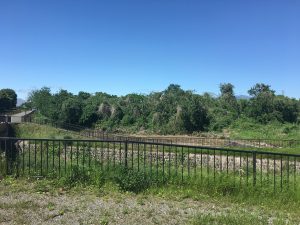
I think I was above all impressed by the scenery in Takasaki. The mountain setting coupled with the strongest winds of my life made for a surreal experience while touring Japan’s ancient tombs. If Takasaki weren’t so far, I would definitely go there more often.
Host Lab Overview
My research project in the Iwasa Lab at the University of Tokyo will be in the field of condensed matter physics, particularly low-dimensional structures. Semiconductors, materials with unique electronic properties, have certain properties that are dependent only on the type of the material, not the quantity. These include the semiconductor’s band structure, which is the array of energy levels it may be found in. However, by making the semiconductor extremely thin in one or more dimensions, it exposes the material to quantum effects. For example, a quantum well is a 2D low-dimensional structure: it may be wide and long, but it is very few atoms thick. Another example is a quantum dot, a structure that is extremely thin in all 3 dimensions. By varying the thickness of a low-dimensional structure in its thin dimension(s), we are actually able to tailor the once intensive properties to our needs. This allows for either greater efficiency or entirely new approaches to electronics, especially in the field of optoelectronics.
Heterostructures take this concept one step further. Instead of simply making a very thin sheet of a single material, we make incredibly thin sheets of different substances and layer them onto each other. Although considerably more difficult to synthesize, these materials allow for even more advanced customization of material properties.
Week 02: Language Learning and Trip to Mt. Fuji Lakes
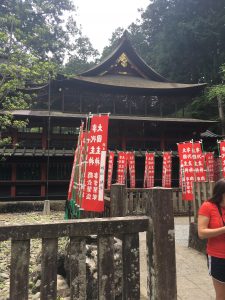
The weekend trip to Mt. Fuji with the 2018 Japanese Fellows was easily my favorite part of the program so far. Our first stop, Kitaguchi Hongu Fuji Sengen, was a beautiful relic of Japan’s past. A shrine dedicated to several kami, but above all the goddess of Mt. Fuji, its interior was richly decorated with ornate gold and red wood. Many people in the group were particularly impressed by the large tori (the largest in Japan), I was personally impressed by the serene atmosphere created within the shrine. It’s supreme calm and reverence was something I had never before experienced. Lunch turned out to be a great opportunity to meet the Japanese fellows and learn about their half of the program. I was surprised to learn that they had only met each other that morning, and was impressed by how fluently they could converse in English.
The 5th Station of Mt. Fuji also provided a unique experience. I am constantly awed by Japan’s natural beauty, especially its mountains, so the opportunity to climb so high into the sky was well appreciated. It was not nearly as cold as I had expected it to be (it was actually about room temperature), and there was not very much to do as the shops’ prices were a bit steep, but I was able to gaze out into an endless sea of clouds above the overcast sky.
Regarding my first impression of the Gotemba Kogen Resort, I found it to be entirely creepy. The massive rusting metallic cutouts of western cartoon characters coupled with a notably sparse population among an ocean of dome shaped houses was unsettling, but upon entering the house I realized just how cozy it was. The acoustics of dome shaped houses was striking; as I talked and walked around the room, my voice would constantly change. Later on in the night, I had a great time representing America for our national sport of competitive eating at the resort buffet, which was spectacularly more luxurious than I expected. It included meguro sushi, steak, and delicious mini-garlic breads that constituted more than my share of calories for the next week. Afterwards, we got to watch a phenomenal water and laser light show.
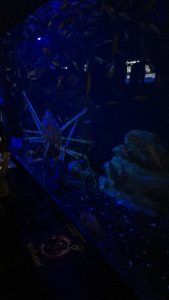
The deep sea aquarium was unlike any other aquarium I have been to in that it specialized in deep sea creatures. However, it was definitely strugglesome to try and read Japanese descriptions for the fish. Curiously, there was also an echidna on display. Lunch afterwards was an experience in and of itself, having to cook my own fish and shellfish. The smoke from the fire kept blowing into my face though, and I got progressively hotter and dizzier as the meal went on. The Mishima Skywalk, like the 5th Station of Mount Fuji, provided an excellent overhead view of Japan’s natural beauty, but on a sunnier day. I was disappointed to hear that the zipline was not yet finished, and that I would have to walk back across the bridge.
My favorite leg of the journey was the strawberry picking. All my life I have been a huge fan of delicious fruits, and the notion of all-you-can-eat strawberries picked straight off the bush was an opportunity that I could not squander. I reached a scrumptious total of 100 red, plump and delicious strawberries before leaving. My only wish was that I was let into the sections with the higher quality strawberries, but I fear that there would be none left in the greenhouse.
All in all, however, the mortar that glued together the whole trip was the time spent as a group on the bus. Getting to talk with the Japanese fellows and find out their motivations and interests help put my own home in perspective, and better understand how some young Japanese people view the world. I was excited to learn that one of them shared not only my interest in anime, but the late Japanese hip-hop artist Nujabes. However, although all of the Japanese fellows were extremely kind, it was sometimes hard to communicate or understand the emotion behind their words due to the language barrier. The Japanese people with whom I have spoken tend to be less facially expressive than Americans. This will be something I will have to look out for in the future. I also look forward to staying in touch with some of the fellows I met using Line, and hopefully spending more time with the fellows who attend The University of Tokyo.
Overview of Week Two of Orientation Program
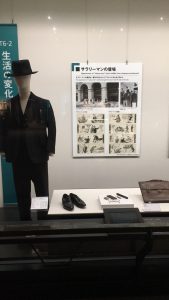
The JAMSTEC site visit was a multifaceted adventure. Not only did walking through Yokohama give me a better understanding of smaller cities in Japan, the JAMSTEC facility tour gave me a better appreciation for how concerned the Japanese are with the environment, and how dedicated they are to protected their land from the natural disasters to which it is tragically so prone.
The Edo Tokyo Museum was impressive with its indoor replicas of Edo era housing and multitude of exhibits. Learning Japanese history from the Japan’s own perspective was intriguing, especially regarding WWII. So often we forget how gruesome the war was, and the fact that more people died in the fire-bombings of Tokyo than in the nuclear bombing of either Hiroshima or Nagasaki. I will always wonder how Japan and America so quickly put behind such an unspeakably brutal conflict.
As for the Grand Sumo Tournament, although the first bits of ritual were fascinating, the time between the fights quickly became repetitive. Having grown up on a diet of jiu-jitsu and judo, I would have enjoyed a higher density of fight-time.
Prof. Shimuzu-Guthrie’s lecture was the most enjoyable one yet. Not only is she hilarious, but the talk helped me better understand the history between the pre-war history between Japan and the US in a more integrated way. It was eye-opening to learn that during its early years, America was known on a global stage, above all, for its agrarian expertise!
Regarding the introduction to science lectures, although I found them all to be quite helpful in refreshing my memory of quantum mechanics and introducing some new content, parts of the Prof. Otsuji’s lecture went a bit over my head. Prof. Saito’s demonstrations were compelling and thought-provoking, and truly displayed the wonder of graphene and graphite. Using graphite to conduct my body heat to cut ice was mind-blowing. However, I was pretty mortified when I messed up solving a very simple set of linear equations twice in a row. Thankfully I will not be in Prof. Saito’s lab and have to live with this embarrassment.
As for Prof. Kono’s key questions about my research project, I do not yet know all the details. However, I will likely be working with two-dimensional Van der Waals semiconducting heterostructures and their electrical properties using both Electron-Beam Lithography and Raman Spectroscopy. The applications of these materials primarily exist for their extremely unique and tailorable electronic properties, allowing them to be used for niche electronic devices.
Week 03: Noticing Similarities, Noticing Differences
Japan’s public transportation system, particularly its subway, exhibits a high degree of order. People typically compact themselves as well as they can, standing or sitting with their bags in front of them, and it is a bit less common to see people eating or drinking. The subways also are notably quieter than those of New York, although they seem to get louder around 7:00pm. I have not had the misfortune of having to try to cram myself on a rush hour train, but they are definitely alien to the relatively sparsely packed New York subways. It seems that older people tend to sleep while on the subway, while salarymen tap away reading or texting on their phones and younger people are play games.
It seems these differences are both cultural and practical. Occupying a smaller space allows for more people to fit on the train, and also is an expression of self-sacrifice for the good of the group so prevalent in Japanese culture. Furthermore, the lack of eating is a manifestation of the Japanese value of cleanliness, while the lack of noise is a manifestation of the Japanese values of peace and quiet. This said, these rules do seem to break down around the end of the business day, or a little thereafter.
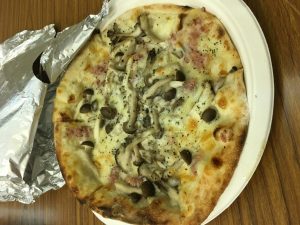
On my free afternoon Monday, I mostly just walked around Azabu-juban, got food and read Japanese textbooks. Professor Nishikawa’s lecture on philosophy was very interesting, especially his interpretation on how Christianity paved the way for the scientific revolution. Bioethics is actually a large program at Case. Ito-sensei’s lecture on kimono and tea ceremony was also elucidating. I never realized just how much spiritual and cultural value is carried with a kimono, and that each one can last for well over a hundred years. His project creating kimono for the Olympics was also intriguing. Ozaki-sensei’s presentation provided me with many useful phrases, one of which I had the opportunity to use today, “つまらないものですが“ when presenting my gifts to Iwasa-sensei.
On Saturday, I went to Akihabara with Ben. After playing (and losing at) some of the claw games Akihabara is known for, we made our way to a Pachinko parlor. Upon reaching the sliding doors, we realized that permanent hearing damage was eminent, so we made our way to the nearest Family Mart which conveniently carried earplugs. Once inside, communication was almost impossible and the flashing lights and quantity of people was overwhelming. After a brief (not so brief) learning curve, we learned how to operate the machines and won some prizes to take back.
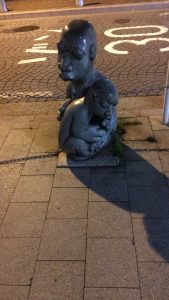
Language classes were frustrating, but I have been making good progress learning Japanese independently. Being able to read kanji is definitely the most fulfilling part of my studies, while speaking and listening remain as the most difficult skills. That said, if I do not know how to directly say something, I am usually able to get my point across. I hope to reach my goal of being able to write and read half of the jouyou kanji by the end of my stay in Japan.
Question of the Week
My question about Japanese culture for the week: What’s with the men in classical Japanese painting making weird faces?
- You may be referring to paintings of kabuki or depictions of demons/gods in Japanese classical painting.
- Japanese Art of Making Strange Faces (Tofugu)
- Kabuki: Painted Faces of Japanese Theater
- Mythology in Art: Depictions of the Storm God in Japanese Painting
- Izumo: Myths and Gods of Japanese History
- 10 Demons and Spirits from Japanese Folklore
Introduction to Science Seminars
Prof. Stanton’s lecture on the theory of semiconductor devices helped put the work of my lab into context. I found the section on the function of blue LEDs particularly interesting, especially how quantum states are funneled into narrower potentials. Futaba-sensei’s lecture on the other hand introduced to me the concepts for the synthesis of carbon nanotubes. While not directly applicable to my research, the concept of chemical vapor deposition was thought provoking due to the scarcity of ways in which one may slow the descent of the seed particles. As for Ishioka-sensei’s lecture, I found the section explaining the advantages of quick, high intensity laser boring the most interesting. It puts into perspective the difference between phonon and electron excitations.
Week 04: First Week at Research Lab
This week, I moved to Shinjuku and began to do research at the University of Tokyo in the Iwasa Lab. In terms of travel, although I had to lug all of my belongings in a trunk, duffle bag and backpack across Tokyo to check in and then go to my share house, it was surprisingly simple. However, as advice, learn what types of things will be provided to you in your house and buy supplementary basic amenities if you can spare the weight beforehand. Hand-soap and towels can go a long way, and can be expensive if you are forced to buy them at a conbini.
The quarters can be a bit cramped (this week I washed my clothes with the understanding that there was a dryer. However, there was not and it has rained since so I have not been able to hang my clothes out to dry) but not as bad as one may expect. Fortunately nobody else in the house uses the kitchen, so I have had free rein to cook. I also have to share a bathroom with only one other person. Also, as another piece of advice, learning the most efficient subway path to your university is vital! While in the US I very rarely had to use public transport, it is absolutely necessary in Tokyo. Also, rooms in Japan are much smaller than those in the US. Take time to organize your belongings so that your living space is actually habitable! (Program Tip: Don’t forget to check out the 100¥ stores too! Seria is especially good for home-goods, organization, and kitchen items).
My neighborhood is a quiet outskirt of the Shinjuku metropolis, which lends itself to being the perfect temporary home. I can enjoy quiet nights around my area, or walk 20 minutes to the adventure that is Shinjuku proper. The grocery store is about 10 minutes downhill from my room, and there are Seven Elevens about 5 minutes away across the street. If I am desperate, there is also a Family Mart (inferior to Seven Eleven) a few minutes away.
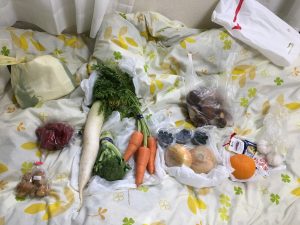
My first week in the lab has been mostly quiet. Although I had very little idea of what was happening on a day to day basis, my mentor Akamatsu-san took me into the lab several times and discussed basic techniques with me. Akamatsu-san is very personable masters student, fluent in English and dedicated to his research. Not only did he select a research topic for us to pursue together, he has helped me integrate myself socially. Although communication can sometimes be hard with some of my labmates, we get along quite well. Outside of the lab, I have been spending most of my time in the office either reading relevant papers or studying Japanese. A warm welcome party was thrown for me on Tuesday, where I had the opportunity to introduce myself.
As for language, I am improving at kanji at a pace that I previously could not dream of. I am currently only focusing on meaning, and covering about 60 new meanings a day with high retention. I highly recommend Heisig’s Remembering the Kanji for this, and for grammar, I recommend Seiichi Makino’s A Dictionary of Basic Japanese Grammar.
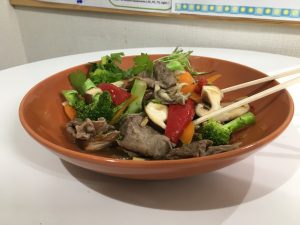
This weekend I visited a monthly farmer’s market near Kachidoki station. I had the opportunity to purchase local vegetables for very low prices and acquire some premium omiyage. I also went to a fabric store in Shinjuku which was like a seven-story Joann Fabrics. Afterwards, I spent some time organizing my room and making stir fry. I highly recommend learning how to make stir fry for those interesting in saving money in Japan. It is cheap, quick, easy and healthy enough, and can be transitioned easily into other dishes.
Reflections on Orientation Program in Tokyo
Reflecting on the Orientation Program, there was a lot to be learned. It was definitely enjoyable to explore Japan and learn about its culture, and important to be briefed in the specific fields of science that I will be pursuing. I also enjoyed meeting the Japanese fellows, one of which I saw today at Todai! Finally, through the travelling done in the orientation program, I have been acquainted with Japan’s unrivaled natural beauty.
The most interesting points I found were Japanese society’s relationship and interpretations of religion. There are very few cases of parallel religious structure quite like that of Buddhism and Shinto. I also found how old Japan has given birth to modern Japan intriguing. The difference between the older and younger generations has also become clearer to me. The global trend moving away from formalism towards casual interaction is definitely present in Japan, which traditionally has been a nation heavily intertwined with rigid and overt social structure.
The most frustrating part of the orientation program was definitely language classes. At first, they were very useful in bringing my speaking abilities in line with my abilities to read and write, but soon became a daily struggle due to my difficulty with understanding spoken Japanese. I definitely poured my heart and soul into studying the language for those three weeks, and I hope that this was reflected in my final speech. I also look forward to taking six credit hours of Japanese language classes next semester, inspired by these classes. The only part of the orientation program that I would consider adjusting, however, would be having a bit more diversity in the science talks. I felt some of the same information was repeated several times across the lectures. However, this said, the information was of utmost importance so perhaps repetition is not such a bad thing.
Through the orientation program, I also learned how attached to my American sense of pride I am. Some of the rigidity of Japanese formal language does not sit well with me, however I accept this situation as a visitor to the country.
Introduction to Research Project
Regarding my research, my first week in the lab was a bit slow while my project was being decided. I spent most of the time in the office either studying kanji, reading physics papers, or talking with the other members of my lab and learning a bit about them and their research projects. It seems the Iwasa group is currently split into three main groups: the Flake Team, the Thin-Film Team and the Quantum Team. While the quantum team is researching quantums dots and particularly modulating their conductivity by adjusting the length of their ligands, the thin-film team is focused on creating quantum wells and heterostructures through chemical vapor deposition and the flake team is concerned with exfoliation techniques.
On Saturday, I learned some of the details of my research project. A paper very recently published in 2018 has shown the process of using optical stimuli to control the magnetic spin distributions within ferromagnets. We will be taking that notion one step further. I will be creating low dimensional chromium antiferromagnets, or highly ordered magnets in which adjacent spins are antiparallel, with the goal of determining whether it is possible to use optics to control the spin distributions in these materials as well. If successful, this will have implications in new optical-magnetic interface technology.
Last week I began my training in clean room etiquette, mechanical exfoliation and chemical vapor deposition. These processes were actually simpler than I expected, and I learned that the process of chemical vapor deposition used in our laboratory is very similar to that of a lab at Case that I visited last year. Our current projected timeline accounts for me becoming competent in performing these processes along with the creation of simple heterostructures and transfer to substrates over the course of this week and the beginning of next week. I will also working through understanding some relevant papers during this time. From there, the timeline becomes fuzzy, but I expect to be both fabricating the samples and determining the properties of these materials. I have not yet been well acquainted with the optical equipment, although I have been introduced to some physical property measurement apparati.
Overall, although details have been trickling slowly, I think our goal is well defined and I am not too concerned at this time.
Question of the Week
Why did the culture of kawaii arise? I have read the articles regarding kawaii on Gaijinpot and Tofugu, and while the former was arguably offensive, Tofugu simply describes the phenomenon. Meanwhile, bigthink.com’s Paul Ratner’s article regarding kawaii offers an almost anecdotal account of how kawaii became so important. My current hypothesis is that kawaii is an evolution of older Japanese culture, evident in the centrality of feminine imagery in Japanese literature. However, I sometimes fail to see a connection.
- You may want to talk with some of the Japanese friends you have made, either in the lab or the Nakatani RIES Japanese Fellows, to learn what they think of kawaii. First, be sure to ask them to define what they think kawaii is. Many Americans might consider manga or anime to fall within kawaii culture, but Japanese students might think differently. What makes something kawaii and why is kawaii a good thing? Are there any negative aspects of kawaii?What about the culture of kawaii in science in Japan? By talking with your Japanese friends about this topic, you might be able to delve a bit deeper than is possible when reading articles and books alone.
- In addition to reading some of the popular media articles on kawaii, you may also want to read some more academic papers and books on kawaii culture. Through the Rice University Fondren Library (login with your NetID and password required), you can search for kawaii culture and more than 100 results are returned for journals and articles. Google Scholar and searching your home university library holdings might also give you access to other articles.
- Books on kawaii
- You might also search for online courses on Japanese Popular Culture like:
Week 05: Cultural Analysis – Life in Japan
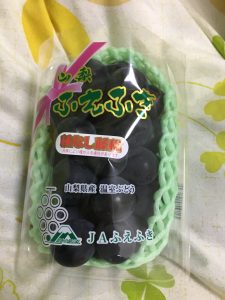
Reflecting on the barriers that I have experienced outside of the lab, the greatest of all is, without a doubt, language. Outside of the lab, the vast majority of interactions I have with Japanese people is through service workers and restaurants, many of whom only speak Japanese. While I am usually able to communicate what I want to say and roughly understand what I am asked, I occasionally still encounter difficulty.
This difficulty usually comes in the form of menus. Searching for a restaurant in Japan can sometimes be difficult as a mildly picky eater as different dishes use niche kanji and it is not always clear what they contain. Although restaurants thankfully employ pictures and models of their food much more commonly than in the United States, straying from the beaten path brings challenges. This week at the recommendation of my mentor I went to a small nearby restaurant known for its rich history which is intertwined with the University of Tokyo. Upon my arrival, however, I was met outside by a sign with handwritten Japanese that I was unable to translate and forced to search for food elsewhere. However, later in the week I had the fortune of accompanying several labmates there for dinner where they were able to explain my options.
Another comical incident came about when I was ordering from a bubble tea stand in Shinjuku. Reading the menu I was able to recognize the kanji for taro, but did not know how to pronounce it. The menu was also too narrow to accurately point out what I wanted, so I resorted to taking my notebook out of my backpack and writing out the words out and presented them to the workers behind the counter, who thought it was rather funny.
Aside from these incidents, I have also found that my acting abilities have improved. It is often more practical to communicate an idea through gesture or a combination of gesture and broken phrase. If all else fails, I try to either draw out or find a picture of what I mean. All of these occasions, however, work to improve my communication skills on every level between reading, writing, speaking, listening and gesture.
All of this said, I think that while I can always find a way to communicate physical ideas, it is often harder to capture connotation and emotions behind words. As time goes on, I realize that my previous assertions that Japanese people are less outwardly expressive than Americans is not as true as I had previously thought, especially among young people. I had mistaken difference for absence. What is also difficult across the board is trying to interpret when individuals for whom English is a second language choose words because of their connotation or simply choose them for their denotation. Some words carry a great deal of meaning aside from their literal translation, and I do not always know if these meanings are intended. In general, I have rarely found the opportunity to have deeper interactions with Japanese people outside of the lab.
Research Project Update
As for my week in research, my mentor has been a bit busy so I have been observing others’ experiments. I learned how to operate and perform exfoliation inside a glovebox. My lab actually gave me the unique privilege of being the first person as far as is known in literature to exfoliate Nickel Diiodide. I used a scotch tape method in the glovebox using a powder form of the crystal and was able to create an approximately trilayer out of the material, as a proof of concept. This week I hope to create a higher quality crystal and trying to exfoliate an even thinner layer. I have also recently been gaining more independence in the lab as I am trusted to perform exfoliation and transfer procedures on my own, although I still have yet to do very much.
Question of the Week
What does an American accent in Japanese sound like beyond the beginner levels to native Japanese speakers? In America, we are often able to detect approximate regions or languages of origin in even the most skilled of English speakers through subtle differences in their patterns of speech. Also, are Japanese people typically able to differentiate between the British Japanese accent, the American Japanese accent, and so on? I believe most are able to tell apart British and American English.
- This would be an excellent question to ask the 2018 Japanese Fellows when you see them at the Mid-Program Meeting. Can they ‘hear’ the differences between English accents when foreigners are speaking in Japanese?
- Things Japanese People Believe About British vs. American English (SoraNews)
Week 06: Cultural Analysis – In the Lab & Preparation for Mid-Program Meeting
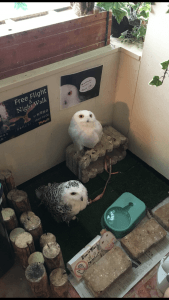
It is difficult to write about direct cultural misunderstandings between the members of my lab and me because I suspect that these misunderstandings do not overtly manifest themselves, and the members of my lab do not seem like the type to eagerly reveal them. This is to say, I do not know what I do not know. Just as outside the lab, the most obvious miscommunications are directly due to language and my inability to read the emotion behind others’ words.
One comical instance of cultural difference, however, is the learning curve I have experienced in using chopsticks. While in the United States I have always used chopsticks to eat Asian food, I have recently come to discover how difficult eating tsukemen is. Although I struggle every day at lunch when the cafeteria was serving it, much to my labmates’ amusement, Hongo’s tsukemen is too delicious to pass up. They also apparently found it comical that I drank the tsukemen broth the first time I ordered it after finishing my noodles. However, I felt bad not finishing all of my food! In return for trying to help me use chopsticks, I later showed some of the people in my lab the Italian etiquette for eating spaghetti (which does not include a constant stream of noodle from plate to mouth).
Another interesting intercultural experience this week came in the form of a trip to Akihabara. Several weeks ago I met an undergraduate student from China who is doing research at Hongo when he visited the Iwasa lab and expressed a desire to become involved. This Sunday he invited me to accompany him and other members of his program to an owl cafe. The other members included another student from China, a student from Mexico who is also studying physics and a student from Japan who studies Spanish. Our group dynamic was interesting because of the distribution of languages that we spoke. While the two Chinese students spoke Chinese, English, and recently began learning Japanese, the Japanese student, Mexican student and I each spoke Japanese, Spanish and English (although each naturally to different levels). Although we found that Spanish was the best common ground, I found myself mixing the languages and switching from one to another when I could not properly explain something, which was a wholly new experience for me. It was also difficult for me to switch back to full English when talking to the Chinese students.
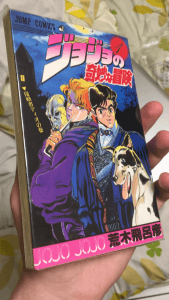
My greatest personal accomplishment so far outside of my research has definitely been the strides I have made in learning Japanese. By the time I reach Kyoto, I will have almost completely learned the individual meanings of the Jouyou kanji, leaving me to learn compound words and pronunciations. My speaking and listening skills have also improved dramatically. However, said that, my ability to communicate is still limited to very literal sentences and understanding the phrasing of others is difficult. The greatest challenge I have faced in Japan has been, as foreseen, the language barrier. I have felt almost like a child unable to understand adults speak, which although has an isolating effect, motivates me to pursue my study even harder. Meanwhile, although I feel behind in my research, I understand that no plan survives first contact with implementation. There is nothing for me to do except keep trying my best.
Research Project Update
This week I successfully completed a transfer of a monolayer of the flake I exfoliated last week onto a high quality substrate and continued observations of glove box exfoliation on new materials. Also, I have been helping to correct the English on important documents for other people in my lab, but sometimes this proves to be more difficult than I had anticipated. In English, there are many correct sentences that one can make that sound incredibly similar but have drastically different meanings. Trying to figure out which was originally intended can quickly become a time-consuming process.
Question of the Week
How do Japanese feel about their police system? While Japan is known for its low crime rates, the more I read about the justice system the more unsettling it becomes. The lack of right to an attorney, the secrecy and duration of police interrogations along with misinforming you about your rights, and a conviction rate of well over 99% support the notion that one is guilty until proven innocent. While there are many vocal critics of the US justice system, I wonder if the same is true in Japan.
- No country’s policy and legal/justice system is perfect. There are challenges and protections, albeit different types of protections inherent in each system. This article, outlines some of the key differences between the legal systems in Japan vs. the U.S.; primarily the difference between the common law legal tradition in the U.S. and the civil law legal tradition in Japan. This can also be understood as a difference between a procedural notion of criminal justice (U.S.) vs a substantive justice (Japan). This Pacific Basin Law Journal paper (PDF) gives a more in-depth view of this topic.
- While the U.S. legal system is mostly inherited from the English legal tradition, Japan’s is a mixture of several main influences. In the late 1800s, early German civil code was imported by Japan, along with elements of the French civil code as well. After World War II, however, a number of American borrowings appeared, such as a constitution and laws regarding criminal procedure, labor law and corporate law. In more recent years, Japan’s legal system was updated, including revisions to codes on topics such as civil procedure and bankruptcy.
- If you ask someone from Japan this question, they might be very surprised. In Japan, the U.S. is seen as being far less safe and the police/legal system much more difficult to navigate than in Japan where there are helpful police officers that you can easily find in any koban (police booth) on most major street corners. You wan walk right in, file a report for a lost/stolen item, or even just ask directions at any time day or night. Police officers also have ‘neighborhood beats’ or areas that they are responsible for patrolling regularly on foot or by bike. This is why, sometimes, you may be asked to show ID by a police officer in Japan. If you are a new face in their local area/district they may be more likely to stop you and for ID, whether you are a foreigner or Japanese.
- That is not to say that there aren’t people in Japan advocating for improvements to the system, particularly when it comes to the rights of permanent residents (non-citizens) in Japan. However, on the whole, most people in Japan likely feel the Japanese criminal justice system is seen as working well, for the good of society/group/all, overall.
Week 07 & 08: Overview of Mid-Program Meeting & Research Host Lab Visit
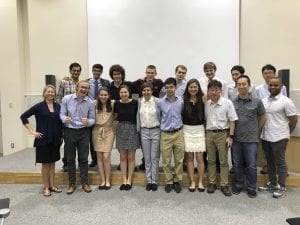
My experience giving my introductory talk at the University of Kyoto was a positive one. I thought my presentation went well, although while presenting it I realized that perhaps my ordering of topics was a bit strange. I therefore went through my slides in a different order. For future presentations, I think I am less worried about my live presentation and more about creating a strong visual presentation.
As for updates on my research project, I am now working with black phosphorus (exfoliated into phosphorene) on a chromium oxide substrate. I am also earning more independence in the lab as time goes on. This week I attempted an exfoliation and transfer (which I spent a great deal of time on) only to learn that we were using a corrupted sample of the black phosphorus.
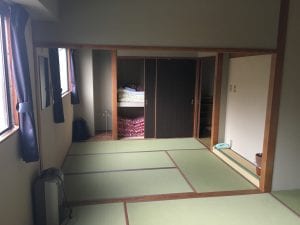
Although I had looked forward to the Kyoto trip, it far exceeded my expectations. For one, it was great to see the Japanese Fellows again. The night before I left, Gen actually helped me purchase my Shinkansen ticket so that we could sit together on the way. Gen and I have actually met a few times since our buildings are right next door to each other at Todai. I arrived a bit early, but I was able to take a taxi with several Japanese Fellows to the Kyoto Traveler’s Inn which made transport unexpectedly simple. Upon my arrival, it was immediately evident that the greatest challenge of the trip would be surviving the sauna that is Kyoto in a tatami-style room. It was made surprisingly more manageable by the fact that I was consistently tired enough to just pass out by the time I got back every night. It was also great to see the US Fellows again, and I spent a lot of time with Ben and Sam.
The most fun part of the Mid-Program Meeting was definitely going to karaoke with the Japanese fellows. Although a lot of the Japanese songs were way too hard for us, Ben and I managed to sing the few that we knew. It was also funny to see what American songs were popular in Japan, and how well the Japanese fellows could sing them.
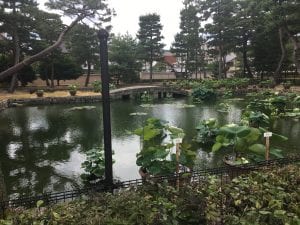
Visiting the temples and shrines around Kyoto was, for me, the most interesting part of the trip. The inner parts of the Kamigamo Jinja shrine, to which we were given special access, had an otherworldly degree of serenity. I wish I could have stayed longer. Meanwhile, I was truly impressed by the architecture of the temple and especially the massive painting of the dragon on the ceiling of Kennin-ji Temple in one of its central halls.
As for the lab visits, it was exciting to see labs outside of my field and see how they compare. Between physics, chemistry and biology, there is definitely a spectrum of orderliness. One of the machines I saw in the first lab visit particularly stood out to me. After casually explaining its function (splitting water streams to differentiate between cells), the guide informed us that the machine costs $100,000,000. He was very clear that it was truly one-hundred million dollars. I cannot even begin to conceive what it must be like to work with something that valuable.
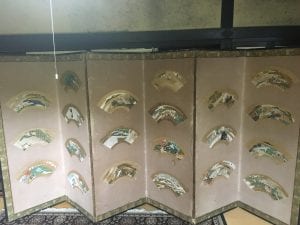
Week 09: Research in Japan vs. Research in the U.S.

This week I had the opportunity to show Sarah and Ogawa-san around the Iwasa lab and update them on my research. Most of the time was spent in the experimental room with the gloveboxes rather than the clean room where we do a great deal of fabrication since going in and out is a hassle. I also got to introduce them to my mentors Akamatsu-san and Ideueu-sensei. Unfortunately, Iwasa-sensei was away from the lab.
The lab actually seems rather relaxed in terms of culture, more so than I expected. There is no set time that anyone arrives or leaves (although I always try to get there before 11:00 AM). It is also very rare to see disagreements and people tend to address each other casually. However, aside from eating lunch together, people usually stick to minding their own business.
The oversight in the lab has turned out to be far less than I expected, and it seems every member operates autonomously and only changes course after being evaluated at the lab group meeting held every other Saturday. Things actually seem less procedural than what I imagine an American lab to be like. Overall, though, it’s difficult to gauge the inner workings of how people interact in my lab because of how quiet it can be. Although I do work with Akamatsu-san closely and eat lunch with the group, I feel like the big picture of the lab is a mystery to me.
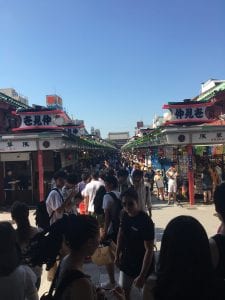
While I originally imagined that academic research in Japan is valued from an angle of effort and staying within the lines, the Iwasa lab is definitely results-driven. Students’ biweekly presentations are picked apart with a fine-tooth comb to the extent that last week our Saturday meeting went from 10:00 AM to around 4:00 PM, being dragged out by the immense scrutiny. Results-driven research is something I would normally expect from an American lab, where students are highly praised for out-of-the-box thinking.
My lab life aside, this week I took a trip to Asakusa where I toured the temples and shops. Not only was the architecture impressive, especially that of the interior of the innermost temple whose rich displays of gold were housed only behind a thin pane of glass. The shops on the other hand were wide and varied. Not only were there many traditional shops selling excellent gifts such as chopsticks, fans, dishes and cutlery, but there were also more modern shopping centers nearby. I also got to watch some sort of festivity where a band playing what sounded like traditional Japanese music on an upraised platform was surrounded by people dancing in a circle.
The next day, I decided on a whim to take the Shinjuku line that I take every day from its first to last stop. Little did I know that the last stop, Motoyawata, is actually in Chiba! I spent the day walking around the neighborhood and getting food before taking the subway back. On an unrelated note, I finally finished the kanji book I was reading, Heisig’s Remembering the Kanji. I now can recognize around 2,200 kanji for individual meaning, but I have a long way to go building up a true vocabulary. My pronunciation has also been getting better lately.

Research Project Update
I am still making progress towards finishing my first device. I have already obtained a useful flake of black phosphorus; I am now working on exfoliating ReS2.
Question of the Week
What is the circle dancing in Asakusa?
- That was most likely a small matsuri, or summer festival. There are tons all throughout Japan all summer long. Some are large and very well known, like Gion Matsuri in Kyoto, but others are much smaller, more local matsuris around various temples and shrines or even just in a local neighborhood. Here is a link to a list of some of the various matsuris you may see in Tokyo during the summer However, some of the smaller/more local ones may not be publicized in the English press/websites.
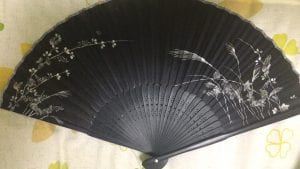
Week 10: Reflections on Japanese Language Learning
My ability to speak and understand Japanese has been of central importance during my entire stay in Tokyo. Being such a large subject, I find it difficult to write about in any manner other than chronologically.
I now appreciate how comically awful my knowledge of the language was when I landed. Although I knew in theory basic pronunciation, kana, sentence structure, a few hundred kanji and some limited vocabulary from Genki, anything I wanted to say or write had to be extremely premeditated and I was still sounding out words painfully slowly, mora by mora. I remember specifically the bus ride from the airport to the Sanuki Club, during which I could barely make sense of any signs.
There actually turned out to be a lot more English in Tokyo than I had anticipated, which I think has been a double-edged sword. While on one hand I can more easily navigate, on the other I have realized it is a crutch after traveling outside of the international hubs of Japan. Our excursion to Yokohama was perhaps one of the most pivotal moments in making me realize just how unevenly distributed English is within the country.
As I have written about before, the language classes at the beginning of the program were initially very helpful in helping me gain more conversational skills and naturalizing the knowledge I already had, as time went on I became very frustrated with the manner in which class was held. Instead of introducing a new concrete idea and building upon it until it became fluid, I felt like many disjointed topics were slung at me in a slurry that I could not keep up with and felt like I was a burden on the class despite how much I tried to study the book outside of class. Halfway through my spirit towards learning Japanese was a bit shattered. In some capacity looking back, however, I wish the class had been longer as towards the end I began to improve my learning techniques.
In Takasaki, seeing Ben’s commitment to his flashcards inspired me to find my own path for learning Japanese, which, at its beginning, was a dive into A Dictionary of Basic Japanese Grammar and Remembering the Kanji, both of which I found excellent. I coupled these with spaced repetition flashcards so that the topics I learn are truly retained, and not just “memorized.” I also have recently started on audio flashcards for listening.
Since then, my study of Japanese has been equal in terms of time spent every day to my study of physics. When I am on the subway or there is no work for me to be doing in the lab, I am always reviewing my flashcards. While in the office, I also have learned shorter phrases and colloquialisms that are harder to pick up from text. Phrases like . Also, although everyone in my lab speaks English to some degree, it is my impression that many find speaking it to be inconvenient. I find myself using Japanese for everything that I can say, and English for everything I still cannot, which more or less resolves to a 50/50 split.
In terms of overall linguistic challenges, communicating with the people in my sharehouse is perhaps above all. A French man lives on the first floor and he speaks limited English, while on the second floor there are several Chinese people, one of which speaks neither Japanese nor English and another who speaks some degree of Japanese. Having to communicate with each other in our mutually imperfect Japanese and have them translate can be a hassle, but usually with gestures we can get our points across. I find that Chinese hand gestures have a lot more in common with those in the West than Japanese.
Research Project Update
Regarding my research this week, Akamatsu-san and I completed our first set of measurements on our first device and presented them in the weekly meeting. However, our results were a bit inconclusive and Iwasa-sensei observed that it is likely due to bubbles forming between the layers of our heterostructure. This was a possibility that we already had in mind, but we feared annealing would destroy the phosphorene layer so we were waiting for such a step to be a last resort. This week we will continue measuring our devices.
Question of the Week
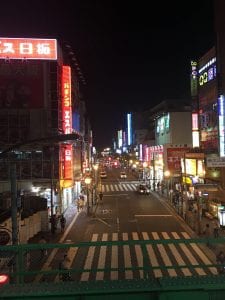
This report has been a bit long-winded, but as a final point, I made a trip to Shin-Ōkubo this week to visit a PC Bang. Given PC Bangs are popular in Korea, it is unsurprising that they would be found in Shin-Ōkubo, which is known for its large Korean population. Essentially, they are a large shared room where people can rent computers for very low prices to play (typically competitive) games on. It was fun to play on the Japanese servers, and afterwards I got to walk around the neighborhood which is notably less upscale than its near neighbor on the Yamanote line, Shinjuku.
Why is it that while mobile games in Japan are so popular (on the subway, it seems like everyone is playing them), playing video games in general is still widely looked down upon?
- Great question to talk more about with the Japanese Fellows. They could likely give you much better insight into how common playing computer-based video games are and/or what young people today think of this hobby. These articles may also be interesting for you to read:
Week 11: Interview with Japanese Researcher
Akamatsu-San
Where are you from, and what was life like growing up?
“I was born in Yokohama, in Kanagama prefecture, and grew up there until the age of 20. And after that, I came to Tokyo and I am currently living by myself. I went to a public elementary school, and when I was 12 (so sixth grade of elementary school) I took an examination and went to a private junior high school. The senior high school was connected to the private junior high school, so I ended up going there for six years. In elementary school I was in swimming club, but in high school I played table tennis. When I was 18, I took the next examination (for Todai). I came to Todai because I wanted to go to the top university in Japan.”
What was Japanese high school like, and how did you end up pursuing applied physics at The University of Tokyo?
“I don’t know American high schools, but I think in Japanese high schools students study much harder than other countries’ students (but of course I do not know for sure). I have heard the Japanese university entrance exams are difficult, so we study harder. I think Japanese students in high school are too busy!”
How do you think undergraduate life is different in the US and Japan?
“As for undergraduate life, of course it depends on the university, but in general Japanese students do not study. In Japan, most students intend to work in an office in the future, but in order to work with a major company one must graduate from a good university. The entrance exam is difficult, but then they don’t study very much for 4 years!”
How would you characterize the Iwasa laboratory? How does it compare to other labs in Japan?
“Of course, this is the University of Tokyo so I think we work on research more than most other labs. Compared to other labs in this faculty, Professor Iwasa is very involved and takes care of students. As you know, he likes to eat lunch with students, but in other labs professors do not. This has a positive influence on our culture.”
What aspect of Japan (outside of family, friends, language, etc.) would you miss the most if you moved away?
“I would miss food the most! My favorite Japanese food is nikujaga. Aside from that, I would miss the crowds of Tokyo.”
What aspect of Japan would you change, given the opportunity?
“I would want to change the educational system. As I said, in high school we have to study hard but in university we don’t have to study in general. So, we have to change. So, if we make the University students study harder, and need to change the current way of the companies recruiting from specific universities and, instead, encourage recruiting based on ability.”
What is your impression of what college life and research are like in America? How about other parts of the world?
“Japanese researchers have less free time! In some countries, researchers take very long breaks for lunch and dinner to talk with each other, but in Japan we work harder (for better or for worse).”
What are your plans for after you finish your Master’s degree? If you intend to work for a company, what kind of characteristics would you want that company to have?
“I had been considering a PhD., but recently I’ve been intending to work in an office. A company which takes care of our health and welfare! I also want to do research that leads to some commodities. I want to do some sort of engineering.”
Do you think studying abroad is important? If so, why?
“Of course I could have, and although I have travelled, I have never studied in other countries. If there is an opportunity, students should study abroad.”
What do you think of taking classes outside of your field of study?
“When I was a bachelor’s student, I took a literature class. That class dealt with Osamu Dazai, and his first book. I also took a German class. I think taking a wide range of classes unrelated to your major is good.”
Ideue-Sensei Interview
What is your educational background, and why did you choose your career path? Did things turn out as you expected?
“I have a PhD of Engineering in Japan, from The University of Tokyo. I chose to study engineering by way of physics. From the first place, I was very interested in mathematics and physics, but I was also interested in applied physics. This is why I chose this department. Actually, my first plan was to work for a company. Actually, I was at one time a company employee, but after that I decided to explore deeper in my field so I returned to this department to complete my PhD. My career path was actually not expected, as I first joined a company. While working for the company, I changed my mind and decided to get a PhD.”
How do you think research in other countries like the US is different from research in Japan?
“I have never worked in a US lab, but I feel, especially for our department, that our lab’s education is very good. I feel the education programs in Japan are very strong. Of course I have never been to a US lab, but I think people tend to work more by themselves. In my opinion, if you have already decided the field you want to work on, you can choose a lab in the US. In Japanese Universities, at the first stage, we may not have the choice of what topics we will work on. However, after experiencing one year of research we can decide.”
What is your international experience regarding your work like?
“I have actually never been to a lab abroad, but I have travelled and attended many international conferences. I also have many international colleagues. Of course international experience is important for STEM students. At least to me, collaboration with other labs abroad is very constructive. Sometimes there are many machines and ideas that we may not have in Japan, and collaboration with other labs abroad who have these is valuable.”
Do you have any advice for undergraduates?
“Don’t hesitate to contact foreign people or famous professors. It’s a good opportunity to collaborate with them or even start a career.”
Reflections on the Interviews
Reflecting on these interviews, it seems that most Japanese people highly value international collaboration. Also, it seems that while the people I interviewed from Japan tend to think their undergraduate schooling is relatively relaxed, they also find their work both before as high school students and after as researchers is grueling. It is also interesting how the Iwasa lab simultaneously balances great individual freedom with a tight sense of lab unity.
Research Project Update
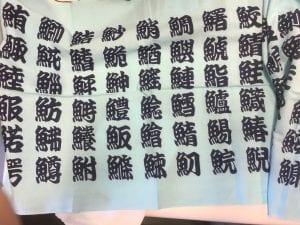
In terms of progress regarding my research this week, it is beginning to look like we will not have time to measure our second device. We are currently finishing measurements on our first device, WSe2 and Phosphorene
Aside from the research, we also had a going away party for me at a yakitori restaurant in nearby Ueno. Although yakitori terrifies me, thankfully I have recently learned yakitori vocabulary so I was able to navigate the minefield of delicacies. I was also given the wonderful gift of a Japanese-style towel covered in the kanji for dozens of types of fish (picture attached). Maybe someday I will be able to read all of them. Afterwards, two of the Japanese students and I had a brief karaoke session before returning home.
Question of the Week
What cultural turns in the road did the West take to be so averse to eating chicken hearts while organ meat seems to be so popular in Japan? I am not convinced that it is simply due to a philosophy of not producing as much waste.
- This is, in part, generational as there are members of older generations (people born in the 1930s – 1960s) that do still eat things like liver and onions (which is why you can still find it on the menu in many small-town diners across the U.S.) and there are also some regional cuisines where you can find ingredients that aren’t so common throughout the U.S. any (e.g. chitlins).
- This is also closely tied to the commodification of mass market/mass produced food and big-box grocery stores in the U.S. This began in earnest in the 1930s and 1940s and by the 1970s and 1980s it was increasingly rare to find stand-alone butcher’s, bakers, or candlestick makers in most U.S. towns. Now, all things could be bought under one grocery store or Wal-Mart roof at lower prices than what the butcher charged for (usually) much fresher and better meat; including the types of cuts that you won’t commonly find in your mass-market grocery store. This standardized the types of food Americans cooked/prepared to a wide extent across the nation and even socieo-economic classes.
- The Surprising Way a Supermarket Changed the World (Time)
- How the A&P Changed the Way We Shop (NPR)
- From the A&P to Amazon: The Rise of the Modern Grocery Store (Washington Post)
- 4 Foods Americans Don’t Eat Very Much Anymore (NPR)
- The WWII Campaign to Bring Organ Meats to the Dinner Table (Atlantic)
- The Science of Disgust: Why (most of us) hate liver, Brussel sprouts, and cricket flour (Washington Post)
- Why Don’t American’s Eat Offal? (Washington City Paper)
Week 12 & 13: Final Week In the Lab & Re-Entry Program
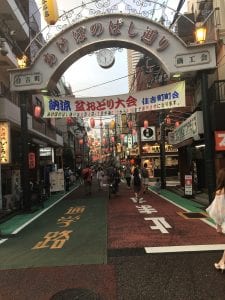
My final weeks of research in Japan were spent taking measurements on the primary heterostructure I created, as well as putting together my poster and presentation for the Nakatani Foundation (which I managed to present in Japanese!). In the end, we created and characterized a new black phosphorus/WSe2 van der Waals heterostructure. Unfortunately, while it does not appear that similar research is taking place in my own university, I do hope to find a research position doing something similar in the future. Also, my lab held a going away party for me at a yakitori restaurant, which I wrote about before.
My final weekend living near Akebonobashi, I visited the Akebonobashi Festival where food was sold on the streets and traditional drums and dancing took place in the evening. On the second day of the festival, I saw men carrying a ceremonial box (that most likely contains a kami) down the road by my sharehouse and watched as people threw buckets of water on them from the windows overlooking the street. Even the local florist came out with her hose. The festival felt like a finale to my stay in Shinjuku-ku.
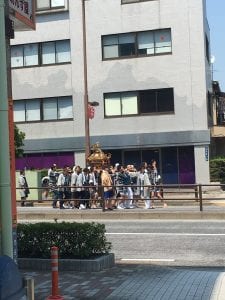
That night, however, I went with one of the people from my sharehouse to a pharmacy across the street that I had visited once towards the beginning of my stay. It seemed that the owners, an older man and what appeared to be his brother and wife, lived in the establishment. They also sold a wide variety of used Japanese goods. After talking with them for a few hours, they brought out small statuettes of our Japanese Zodiac animals as gifts for us. They were particularly excited about our passion for Japanese. I also bought a kimono from them for only one thousand yen, which was apparently at one time one of their family member’s.
After that, it was time to wrap up in Azabu. Returning to the Sanuki Club hotel was surreal. The smell of the wood in the lobby was strangely nostalgic as I slowly came more and more to grips with the fact that I would be leaving Japan. I felt that my performance on the AJALT test was a vast improvement over my initial testing, and I was able to present my final presentation regarding my research to the Nakatani Foundation at the University of Tokyo entirely in Japanese. Although it was stressful practicing to present in another language, and I had to skip a bit of one of the slides to make time (our presentations were changed from 6 minutes to 5 minutes), overall it went well and I was proud to display my parallel personal developments.

My final night I spent as I did many others, wandering through the streets of Tokyo. I walked with Ryotaro from the University of Tokyo to Ochanomizu, where we said our final goodbyes. I was stunned by the vast number of music stores in the district, with guitar shop after guitar shop lined up on the main strip. I then wandered until I found a subway stop that would bring me eventually to Akihabara, where I made my final attempts to stock up on gifts to bring back for my friends. Afterwards, I traveled back down to Roppongi where I met with some of the US fellows before going back to bed.
I miss too many things to count about Japan. For one, having the opportunity to converse in Japanese every day had me constantly thinking and improving in the language. Secondly, the public transportation in Tokyo gives so much freedom. Wherever I wanted to go in the city I could reach quickly, conveniently and inexpensively. I will also miss the food! Even though I was not the biggest fan of all of the dishes and definitely missed American food, there are some things that cannot be found anywhere else.
There are some things, however, that I will not miss about Japan. For one, the transfer from the Shinjuku line to the Namboku line at Ichigaya station! More seriously, however, is the lack of agency due to my inability to speak Japanese fluently. I definitely felt gated in what I could do and the friends I could make due to my inability to simply converse. It has definitely impressed upon me the necessity of speaking the language of the land and has also made me consider how difficult it must be for people coming to the United States who do not speak English.
What Would You Tell People About Nakatani RIES?
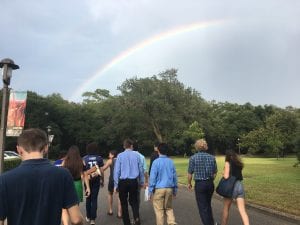
In reflection over my time in Japan, I find I have changed as a person in ways that one may not have expected. Something that is easy to forget is that while I was in Japan, my life itself was still progressing. For one, I find that I am a calmer person. Although it is hard to pinpoint exactly why, I do know that on a daily basis in Japan I would be met with fresh challenges and forced to think in new ways. I learned to take these in stride and place greater confidence in myself to solve them.
My perceptions towards both Japan and the United States also changed. I now appreciate Japan as a society that places great value in quality and form. Every single product I purchased in the country was of superior quality, which is reflective of the importance Japanese culture places on doing things correctly and specifically for the sake of doing them that way. Even the most basic daily interactions have a certain ritual to them, such as handing people things and checking out at the grocery store. Conversely, I now realize the emphasis upon efficiency and explicitness that America places.
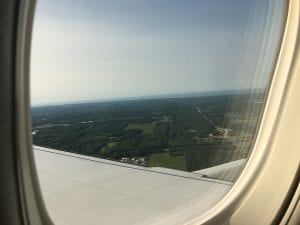
When speaking to a family member, I would say that the most important things I learned from Nakatani RIES were how to live on my own on the other side of the globe, and better appreciate how the world as a whole fits together by seeing how similar and different its pieces are. When speaking to a professor, I would say that the most important things I learned during Nakatani RIES was both how university labs operate and especially those in Japan. I would also talk about the importance of international collaboration for the progress of science. Speaking to a potential employer, I would highlight the strong cultural awareness I developed and ability to overcome barriers to collaboration. Furthermore, I would say that the program was an exercise in adaptability and solving new, unforeseen problems every day.
Speaking to a student at my university, I would talk about how much my perspective of the world broadened and the quality of the hands-on research experience that fellows receive. As a result of my participation in Nakatani RIES, my interest in Japan has grown even larger. I am taking two Japanese classes this semester, 301 and linguistics, and am continuing rigorous self-study. I am also now looking for research opportunities at my university in either semiconductors or quantum computing.
Final Research Project Overview & Poster
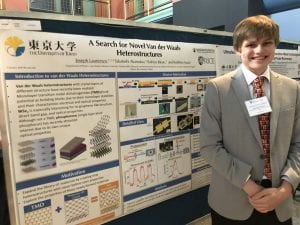
Host Lab in Japan: The University of Tokyo – Dept. of Applied Physics and Quantum-Phase Electronics Center, Iwasa Laboratory
Host Professor: Prof. Yoshihiro Iwasa
Research Abstract and Poster: A Study of Novel Van der Waals Heterostructures (PDF)
As for the Re-Entry Program Sessions, the workshop in which we learned how to better present our posters was particularly helpful for me. I had never done anything like it before, and the tips I received were incredibly insightful. I felt far more confident presenting my poster for real, and even now I use some of the skills I learned in everyday conversation! (“Oh, I was just talking about. . . Would you like to know more?”) The Nakatani RIES Fellowship has made me far more interested in pursuing other research programs in Japan and even graduate school at The University of Tokyo. However, I am still on the fence as to whether I want to study theoretical or applied physics.
Presenting my poster at the SCI Colloquium at Rice University was draining and challenging, but an irreplaceable experience. Not only did I get to share what I had spent my summer doing, I had the opportunity to talk about my research with so many wonderful people, many of which that work in my fields of interest or study completely different things that I may have never learned about otherwise. It is hard to say what went well and what did not, but I hope to work on my posture and diction for future presentations. I attended most of the other SCI oral talks that gave me glimpses into novel fields of research, the most interesting to me being the liquid crystals that are capable of transitioning between two completely different shapes.
Follow-on Project
I am currently in contact with both the head of the physics department and the head of the gifted program at my local high school and middle school and am trying to set up a presentation to talk about my research, studying abroad and pursuing careers in STEM. I will also be submitting an article to Case Western Reserve University’s “NIHONGO NEWSLETTER” talking about the program and my experiences in Japan.
Tips for Future Participants
Pre-Departure Tips
- The most important thing for living in Japan is, in my opinion, speaking Japanese. Being able to efficiently communicate will open so many doors for you and enhance the overall experience. The earlier you start practicing and learning, the better.
- It is also a good idea to read through previous fellow’s weekly reports to see what life and research is like in better detail. Also, if you are picky, it might be important to learn how to cook.
Japanese Language Tips
- During the orientation program, actually read the sections for Japanese class before coming to class. It will take you a little while every day, but it is worth the effort.
- Reading Genki 1 and Genki 2 and Heisig’s Remembering the Kanji will be a strong foundation. I also strongly suggest spaced repetition software such as Anki.
Working With Your Research Lab
- Be proactive! If things are slow or there is not much for you to do, try to observe others or ask around and see if there is anything you can do. Also. try and get a student card at your university! Finally, not every lab in Japan necessarily fits the “Japanese-style lab” mold.
Living in Tokyo
- Try to get around! There’s a lot to see in the city. My favorite district is Asakusa, which is a historical district where you can buy traditional Japanese handicrafts and visit shrines.
- Also look into buying a monthly subway pass, it may be cheaper if you are commuting along the same lines every day.
- Try to buy soap and towels before moving in, or you may be forced to buy them from a conbini where they will be significantly more expensive. Also, make sure to shop at Don Quixote!
- Honestly, there’s so much going on in Tokyo that I think it’s worth figuring out for yourself. Even in my little section of Akebonobashi I was constantly finding new things.
Mid-Program Meeting in Kyoto Tips
- Make the most of your time in Kyoto! Also, it is okay if you haven’t finished any research yet, a lot of people experience difficulty during their first few weeks in the lab.
What to Eat
- The University of Tokyo’s Karamiso Ramen. Also, Ichiran Ramen. Lifechanging.
